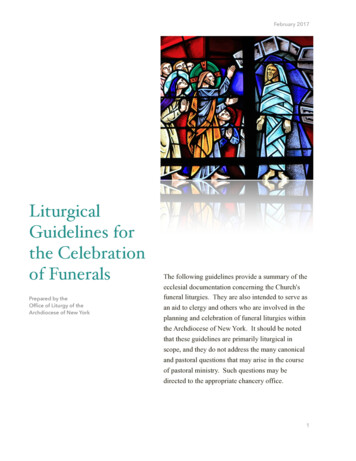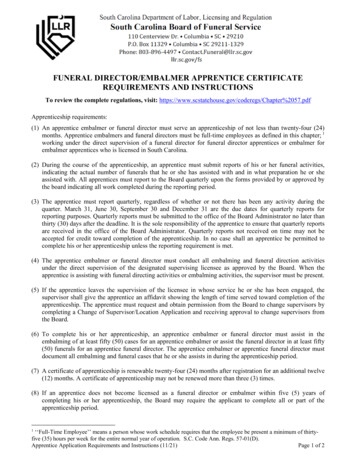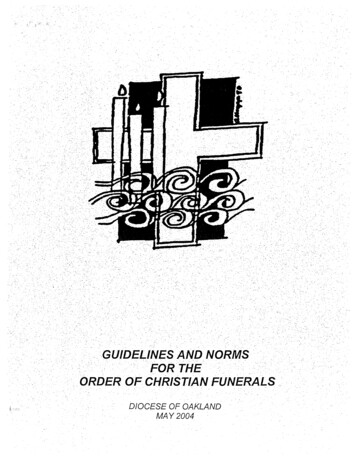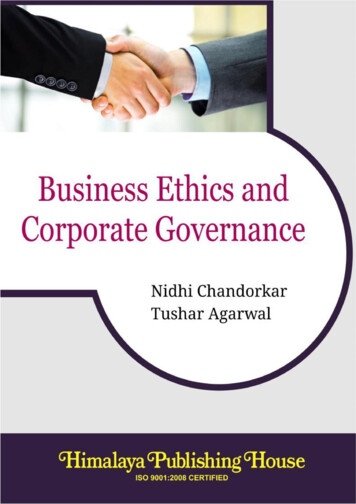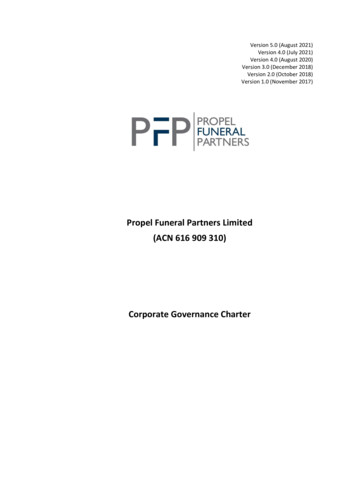
Transcription
Version 5.0 (August 2021)Version 4.0 (July 2021)Version 4.0 (August 2020)Version 3.0 (December 2018)Version 2.0 (October 2018)Version 1.0 (November 2017)Propel Funeral Partners Limited(ACN 616 909 310)Corporate Governance Charter
DefinitionsAnnual General Meetingmeans an annual general meeting of the Company.Anti-Bribery and CorruptionPolicyASXmeans the Company’s anti-bribery and corruption as set out in section 10 of this Charter.ASX Listing Rulesmeans the Listing Rules adopted by the ASX, as amended from time to time.ASX Recommendationsmeans the ASX Corporate Governance Council "Corporate Governance Principles andmeans ASX Limited (ACN 008 624 691).Recommendations” (as amended from time to time).Audit and Risk Committee Policymeans the Company’s audit and risk committee charter as set out in section 8 of thisCharter.Boardmeans the Company’s board of directors, from time to time.Board Policymeans the policy of corporate governance in relation to the Board contained in section 1of this Charter.Chairpersonmeans the chairperson of the Board from time to time.Chartermeans the corporate governance charter set out in this document.Code of Conductmeans the Company’s code of conduct as set out in section 3 of this Charter.Company or Propelmeans Propel Funeral Partners Limited (ACN 616 909 310), and, where the context admits,its subsidiaries from time to time.Company Secretarymeans the secretary of the Company, from time to time.Constitutionmeans the constitution adopted by the Company, from time to time.Continuous Disclosure Policymeans the Company’s continuous disclosure policy as set out in section 2 of this Charter.Corporations Actmeans the Corporations Act 2001 (Cth).Directormeans a director of the Company, from time to time.Diversity Policymeans the Company’s diversity policy as set out in section 6 of this Charter.Employeemeans employees of the Company.Insider Trading Policymeans the Company’s insider trading policy as set out in section 5 of this Charter.Investment Strategymeans acquiring assets which operate within the death care industry in Australia and NewZealand such as: (a) private funeral home operators; (b) funeral related properties andinfrastructure and (c) cemeteries and crematoria, and such other strategy adopted by theBoard from time to time.KMPmeans the key management employees and members of the senior executivemanagement team determined by the Board from time to time, being at the date that thisCharter was adopted, Albin Kurti, Fraser Henderson and Lilli Gladstone.Privacy Policymeans the Company’s privacy policy as set out in section 7 of this Charter.Remuneration and Nominationsmeans the Company’s remuneration and nominations committee charter as set out inCommittee Policysection 9 of this Charter.Risk Management Frameworkmeans the Company’s risk criteria framework and risk and compliance controls register.Shareholdermeans a holder of shares in the Company.Security Trading Policymeans the Company’s security trading policy as set out in section 4 of this Charter.Websitemeans the Company’s website is maintained at www.propelfuneralpartners.com.au.2
Propel Funeral Partners Limited(ACN 616 909 310)IntroductionCorporate governance is a set of systems, policies and procedures which define the way in which a company isgoverned. It establishes the objectives of a company ensuring that the administration and management of acompany is undertaken in a manner which is consistent with the interests of the company’s shareholders.Additionally, it establishes a system for monitoring and evaluating the achievement of those objectives.The ASX Recommendations define corporate governance as "the framework of rules, relationships, systems andprocesses within and by which authority is exercised and controlled in corporations".Corporate governance policies will vary from company to company as there is no single system of corporategovernance that is applicable to all companies. A company must establish systems, processes and policies thathelp it achieve its objectives in light of the nature and size of that company.As a result, the Company has adopted a number of policies to ensure that it has high-quality and transparentsystems of corporate governance in place. These policies are incorporated in this Charter and are prepared inline with the ASX Recommendations which the Board recognises as best practice guidelines.This Charter incorporates the following:(a)Section 1 - Board Policy(b)Section 2 - Continuous Disclosure Policy(c)Section 3 - Code of Conduct Policy(d)Section 4 - Security Trading Policy(e)Section 5 - Insider Trading Policy(f)Section 6 - Diversity Policy(g)Section 7 - Privacy Policy(h)Section 8 – Audit & Risk Committee Policy(i)Section 9 - Remuneration and Nominations Committee Policy(j)Section 10 - Anti-Bribery and Corruption Policy3
1.Board Policy1.1.IntroductionDirectors will be appointed and removed in accordance with the Corporations Act and the Constitution.The conduct of the Board is governed primarily by the Constitution. The Board Policy aims to set out thepractices that the Company has established and to which the Board and each Director is committed. The BoardPolicy is simply an aid to the Board and the Directors. In the course of undertaking its responsibilities, the Boardmust at all times act in a manner that is consistent with its duties and obligations as imposed by the Constitution,the ASX Listing Rules and by the law. Should there be any inconsistency between the Board Policy and theConstitution, the Constitution shall prevail.1.2.ResponsibilitiesThe Board is responsible for the overall operation, strategic direction, leadership and integrity of the Company,and in particular, is responsible for the Company’s growth and profitability. In meeting its responsibilities, theBoard shall undertake the following functions:Strategic Direction(a)Providing and implementing the Company’s strategic direction, having regard to the InvestmentStrategy.(b)Directing and monitoring the Company’s performance against the Investment Strategy.Risk management and reporting(a)Reviewing and overseeing the operation of systems of risk management ensuring that the significantrisks facing the Company are identified, that appropriate control, monitoring and reporting mechanismsare in place and that risk is appropriately dealt with.(b)Monitoring and appraising financial performance, including the approval of annual and half yearfinancial reports and liaising with the Company’s auditor.(c)Put in place sound systems of risk management and internal controls and ensure that the systems andcontrols are operating effectively in all material respects in relation to financial reporting risks.Management(a)Monitoring and assessing the performance of the KMP and ensuring that their actions are consistentwith the Investment Strategy.(b)Ensuring that appropriate and effective remuneration packages and policies are implemented by theCompany, having regard to the Constitution.(c)Monitoring and reviewing business results, outsourced service providers and the Board itself.(d)Ensuring the Board is comprised of individuals who are best able to discharge the responsibilities ofDirectors having regard to the law and the best standards of governance.Remuneration(a)Ensuring appropriate remuneration policies and practices are in place for KMP and the Non-ExecutiveDirectors, while having regard to the guidelines issued by the ASX in this regard.(b)The allocation and amount of remuneration for the Non-Executive Directors will be reviewed everytwelve months and will reflect market rates.4
Performance(a)Formation and monitoring of corporate governance policies, codes of conduct and committees.(b)Undertaking a performance evaluation of the Board, from time to time.(c)Reviewing and overseeing internal compliance and legal regulatory compliance.Corporate governance(a)Ensuring compliance with the Constitution and with the continuous disclosure requirements of the ASXListing Rules and the Corporations Act.(b)Communicating with, and protecting the rights and interests of, all Shareholders.1.3.Board CompositionThe composition of the Board is determined as follows:(a)The Company’s Board shall comprise of a minimum of three Directors, at least two of which will beAustralian residents, and a maximum of eight Directors.(b)The Board must be comprised of members with expertise, experience and skills relevant to the businessof the Company.(c)The Board will determine the number of independent (non-executive) Directors it considers appropriatebased on the size, nature and complexity of the business at any given time.1.4.Company SecretaryThe Company Secretary is directly accountable to the Board, through the Chairperson, on all matters to do withthe proper functioning of the Board.1.5.IndependenceThe ASX Recommendations establish a number of factors that may be considered when assessing theindependence of Directors. The factors are whether a Director:(a)is a substantial shareholder of the Company or an officer of, or otherwise associated directly with, asubstantial shareholder of the Company;(b)is employed, or has previously been employed in an executive capacity by the Company (or relatedentity), and there has not been a period of at least three years between ceasing such employment andserving on the Board;(c)has, within the last three years, been a principal of a material professional advisor or a materialconsultant to the Company (or related entity), or an employee materially associated with a serviceprovider;(d)is a material supplier or customer of the Company (or related entity), or an officer or otherwiseassociated directly or indirectly with a material supplier or customer; and/or(e)has a material contractual relationship with the Company (or related entity), other than as a Director.These factors are only indicators of matters in which to assess the independence of a Director. The Board willassess the independence of each Director in light of the interests disclosed by them. The Board’s assessment ofthe independence of Directors will be disclosed in the Company’s future annual reports (to the extent deemednecessary).5
1.6.CommitteesThis section 1.6 is to read in conjunction with section 8 and section 9.The Company recognises the importance of establishing audit, risk management, remuneration and nominationcommittees as good corporate governance in circumstances where appropriate for the size, nature andcomplexity of the Company.The Board has established an audit and risk committee and a remuneration and nomination committee, whichconsists of the non executive directors of the Company. The current chair of the audit and risk committee isNaomi Edwards and the current chair of the remuneration and nomination committee is Jonathan Trollip. Thecharter of, and other matters relating to:(a)the audit and risk committee is set out in section 8 below; and(b)the remuneration and nomination committee is set out in section 9 below.The Board will review its view on these committees in line with the ASX Recommendations and in the context ofany changes to the size or nature of the Company and, if required, may establish committees to assist it incarrying out its functions. At that time, the Board will adopt a policy or charter for such committees inaccordance with the ASX Recommendations and industry best practices.1.7.Appointment and RetirementThis section 1.7 is to read in conjunction with section 8 and section 9.AppointmentThe Board will consider the appointment of a Director as and when a vacancy arises in accordance with thefollowing considerations:(a)the skills, expertise and experience of any proposed appointee;(b)the relevance and appropriateness of these skills, expertise and experience when compared to thoseof the current Board;(c)diversity of the Board;(d)the results of any background check which the Board undertakes;(e)the terms of appointment must be in accordance with the Constitution, the Corporations Act and theASX Listing Rules; and(f)the terms of appointment must be recorded in a letter of appointment taking into consideration theASX Recommendations, and if appointed this will form the basis of the written agreement between theCompany and the Director.The Board will provide shareholders with all material information in its possession relevant to a decision onwhether or not to elect or re-elect a Director.Prior to making any formal offer, a potential appointee must be given sufficient information about the Companyto allow the potential appointee to conduct his / her personal due diligence. The information will extend to nonpublic information and care must be taken to ensure confidentiality.6
RetirementA Director must retire in accordance with the Corporations Act, the ASX Listing Rules and the Constitution. ADirector may be re-elected if the Constitution permits. The Board will institute succession planning for Directorsand the Chairperson to ensure a prompt suitable replacement in the case of a vacancy.1.8.Induction and InformationInduction ProgramThe Remuneration and Nominations Committee is responsible for arranging for the new Director to undertakean induction program to enable them to gain an understanding of:(a)the Company’s investments;(b)the Company’s financial, strategic, operational and risk management position;(c)their rights, duties and responsibilities; and(d)any other relevant information.As part of this induction program, a new Director will meet with all incumbent Directors (if this has not alreadytaken place).Ongoing InformationThe Directors must be conscious to ensure that updated information is provided to the Board in a timely fashionto enable the Directors to effectively discharge their duties as Directors.Directors are entitled to request and receive such additional information as they consider necessary to supportinformed decision-making. Any Director has the authority to seek any information he/she requires from theKMP.Directors are entitled to receive appropriate professional development opportunities and maintain the skills andknowledge needed to perform their role as Director effectively. The Board will consider what is appropriate inthis regard and the costs of such professional development must be reasonable when considered against theInvestment Strategy and the Company’s business plan.1.9.Advice, Security Trading and PerformanceIndependent AdviceIn the performance of their duties as Directors, the Directors have a right to seek independent legal or otherprofessional advice at the Company’s expense.Director Security TradingThe Security Trading Policy imposes restrictions on the trading of the Company’s securities by people, includingDirectors, with undisclosed price sensitive information. All Directors must follow the Security Trading Policy.PerformanceDue to the current size of the Company, the Board is responsible for the evaluation of its performance and theperformance of individual Directors and the KMP. This internal review is to be conducted from time to time and,if deemed necessary, will be facilitated by an independent third party. To determine whether it is functioningeffectively, the Board shall, from time to time:(a)review this policy; and7
(b)1.10.perform an evaluation of the Board’s performance.Ethical standards and Security TradingThe Directors must perform their duties in line with the Company’s objectives and with the utmost integrity.Furthermore, the Directors must comply with the Code of Conduct, the Security Trading Policy and the InsiderTrading Policy as set out in sections 3, 4 and 5 of this Charter.1.11.Compliance with LawsThe Company must comply with the Corporations Act, the ASX Listing Rules as well as all other applicable laws,statutes and policies.1.12.ConstitutionThe Constitution is a key governance document. The Board must ensure that it complies at all times with theprovisions of the Constitution.8
2.2.1.Continuous Disclosure PolicyIntroductionThe objective of the Continuous Disclosure Policy is to ensure that the Company complies with its continuousdisclosure obligations under the Corporations Act and the ASX Listing Rules. Additionally, the ContinuousDisclosure Policy aims to:(a)ensure that information issued by the Company is issued to Shareholders and the market in a timelymanner;(b)promote investor confidence in the integrity of the Company and its securities; and(c)generally promote investor protection and protection of the market.2.2.Continuous disclosureAn ASX listed company is subject to the continuous disclosure requirements under the Corporations Act and theASX Listing Rules, in addition to the periodic and specific disclosure requirements in the ASX Listing Rules.The continuous disclosure obligation is contained in ASX Listing Rule 3.1 and states that the continuousdisclosure obligation will be breached by a company who intentionally, recklessly or negligently fails to notifythe ASX of information that:(a)is not generally available; and(b)a reasonable person would expect, if it were generally available, to have a material effect on the priceor value of its securities.Contravention of continuous disclosure obligations can extend to a person who is involved in a contravention ofthe continuous disclosure regime by a disclosing entity.2.3.Disclosure exceptionThe continuous disclosure obligation is not applicable where:(a)a reasonable person would not expect the information to be disclosed;(b)the information is confidential and the ASX has not formed the view that the information has ceased tobe confidential; and(c)one or more of the following applies:(a)it would be a breach of a law to disclose the information;(b)the information concerns an incomplete proposal or negotiation;(c)the information comprises matter of supposition or is insufficiently definite to warrantdisclosure;(d)the information is generated for internal management purposes of the Company; or(e)the information is a trade secret.To rely on the exception, the above three requirements must be satisfied. Should one of the exceptions nolonger be applicable then the company can no longer rely on these exceptions and must disclose the informationimmediately to the market.9
2.4.ComplianceThe Company will ensure compliance with the Continuous Disclosure Policy and will:(a)disclose price sensitive information to the ASX as soon as it becomes aware of that information;(b)ensure that the information is not false, misleading or deceptive so as to avoid creating what wouldconstitute a false market; and(c)ensure that the information is disclosed clearly (expressed objectively), accurately and is complete.In so doing, the Company will ensure compliance with ASX Listing Rule 15.7, which requires an entity not torelease information to any person until it has given the information to the ASX and has received anacknowledgement from the ASX that the information has been released to the market.2.5.Price Sensitive InformationThe Company will ensure that all price sensitive information is released to the market in accordance with theASX Listing Rules and in accordance with the announcements procedure in section 2.9 of the ContinuousDisclosure Policy.Price sensitive information is information that:(a)a reasonable person would expect will have “a material effect on the value or price” of securities; and(b)if the information were publicly available “would, or would be likely to, influence persons who commonlyinvest in securities in deciding whether to acquire or dispose of those securities”.Price sensitive information includes information relating to a takeover bid or a merger, proposed acquisition ordisposal of a material asset, material variations in earnings or profits from previously published forecasts, amaterial change to the business plan, loss of a material contract and major litigation.2.6.Loss of ConfidentialityWhere confidentiality is lost as a result of a specific rumour or media comment then the Company must respondto media speculations to the extent that such responses are required to correct or prevent a false market. Indetermining whether confidentiality is lost, the Company will look at previous announcements it had made andwill consider any likely reaction of the market or particular investors to such speculation.2.7.Administering Corporate Governance ComplianceThe Continuous Disclosure Policy will be administered as follows:(a)the Board will be involved in reviewing significant ASX announcements and ensuring and monitoringcompliance with the Continuous Disclosure Policy; and(b)the Board has the responsibility for ensuring that all relevant information is released to the market in atimely manner in consultation with the Board.2.8.Administration of the Continuous Disclosure PolicyThe Board has overall responsibility for ensuring that the Company is compliant with its disclosure obligations.The Board is responsible for the overall administration of the Continuous Disclosure Policy, particularly inrelation to the following:(a)communicating with the ASX;10
(b)reviewing proposed announcements and consulting with the Board, the disclosure committee (refersection 2.9) and advisors, as necessary;(c)implementing reporting processes for materiality of information;(d)reporting on continuous disclosure issues regularly to the Board;(e)keeping a record of ASX announcements;(f)monitoring and reporting to the Board on the effectiveness of the Continuous Disclosure Policy in lightof the ASX Recommendations; and(g)regularly reviewing the Continuous Disclosure Policy in light of legislative changes or otherdevelopments.2.9.Announcements ProcedureThe Company has established a disclosure committee for the purposes of monitoring whether a matter needsto be disclosed and, if so, to what extent. Generally, the disclosure committee, which is constituted by any twoDirectors, is responsible for decisions relating to the making of market announcements, and will authoriseannouncements of significance to the Company. The Company’s announcements to the ASX will be managed inaccordance with the following procedure:(a)as soon as a Director becomes aware of any price sensitive information the Board is to be notified;(b)the disclosure committee will review and assess that information and determine whether it needs tobe disclosed or whether it needs to be further discussed with the Board;(c)if an announcement of price sensitive information is required, the KMP will prepare a draftannouncement;(d)the KMP will provide the draft announcement to the disclosure committee for their approval;(e)following the approval of an announcement of price sensitive information by the disclosure committee,the Company Secretary will then lodge the announcement with the ASX electronically; and(f)after receiving acknowledgement from the ASX that the announcement has been released, theCompany Secretary will ensure the announcement is accessible from the Website.2.10.No Comments PolicyThe Company has adopted a “no comments” policy in relation to any market speculation or rumours and theContinuous Disclosure Policy must be observed by all Directors and KMP at all times. In light of this, the Companymay issue an announcement in response to a market speculation or rumour where it is necessary to do so toeliminate the possibility of a false market or contravention of the ASX Listing Rules.As part of the Company’s management of investor relations, the KMP may conduct briefings with analysts orinvestors from time to time. However, the Company’s policy for conducting these briefings will be to ensurethat no material price sensitive information is announced prior to it being announced to the market.See the Insider Trading Policy in section 5 for further details.2.11.Responding to Analyst Reports and ForecastsIf a draft report has been sent to the Company for comments, the report should be forwarded directly to theBoard. The Company will not endorse any reports, and will restrict any comments to factual matters and matterswhich have been previously disclosed to the ASX. See the Insider Trading Policy in section 5 for further details.11
2.12.Trading HaltsIn certain circumstances, the Company may need to request a trading halt from the ASX. The Chairperson inconsultation with the Board and the KMP will make decisions in relation to trading halts and the only personnelauthorised to request a trading halt on behalf of the Company will be the Chairperson and the CompanySecretary, with the approval of the Board.2.13.AdvisorsTo ensure compliance with its obligations under the Listing Rules, the Company may from time to time requireadvisors to advise on its adherence to the Continuous Disclosure Policy. The Company may ask such advisors tosign a confidentiality agreement before disclosing any information to them.2.14.Contravention of PolicyNon-compliance with the continuous disclosure obligations may constitute a breach of the Corporations Act andthe ASX Listing Rules. This may result in fines for the Company, personal liabilities for Directors and other officersand damage to the Company’s reputation. The Company takes continuous disclosure very seriously and will nottolerate any deviation from the Continuous Disclosure Policy by any person and will take disciplinary actionwhere a contravention arises. Disciplinary action may include dismissal.2.15.Shareholder CommunicationsThe Board aims to keep Shareholders informed of all major developments affecting the Company's activities andits state of affairs through announcements to the ASX, releases to the media and dispatch of financial reports.All such announcements are also placed on the Website.These include:(a)the half year report;(b)the annual report;(c)the notice of Annual General Meeting and the Chairperson’s address;(d)ASX announcements made to comply with the Company’s continuous disclosure requirements; and(e)occasional correspondence sent to Shareholders on matters of significance to the Company.The Board encourages full participation of Shareholders at the Annual General Meeting or any general meetingof the Company to ensure a high level of accountability and identification with the Company’s strategy and goals.The Company’s auditor will be asked to attend the Annual General Meeting to answer questions fromShareholders relating to the audit.The Company’s annual report is the main vehicle for communicating with Shareholders on the activities andperformance of the Company in the previous 12 months. The annual report will be posted on the Website andwill be downloadable.The Company will also provide Shareholders with the option to receive communications from, and sendcommunications to, the Company and its share registry electronically.2.16.Ethical Standards/Business ConductThe Company actively promotes a set of values designed to assist all personnel in their dealings with each other,competitors, customers and the community. The Company has adopted a Code of Conduct policy and SecurityTrading Policy which are set out in sections 3 and 4 of this Charter respectively.12
3.Code of Conduct3.1.IntroductionThe Company is committed to maintaining ethical standards in the conduct of its business activities. TheCompany’s reputation is important to its ongoing success and it expects all its Directors and Employees to befamiliar and have a personal commitment to meeting these standards.3.2.Purpose of the CodeThe Board has adopted the Code of Conduct to define basic principles of business conduct. The Code of Conductrequires Directors and Employees to abide by the policies of the Company and to the law. The Code of Conductis a set of principles giving direction and reflecting the Company’s approach to business conduct and is not aprescriptive list of rules for business behaviour.3.3.ValuesAt Propel, we are committed to providing our client families with high standards of service and care, helpingthem when they are in need.Our client families are at the heart of what we do. We are here to help them at one of the most difficult timesin their lives and we are honoured to serve the communities of which we are part.Listening to our client families and understanding their needs must drive what we do.We aim to provide excellent client service through the continued dedication of our people and by serving ourclient families with:3.4.-Respect: being trusted with something as important as someone’s final wishes is an honour and aprivilege that we must never take lightly, and we must do so respectfully;-Compassion: being there for our client families in every way that we can, having the courage to adviseand direct our families with empathy and compassion, to let the healing begin; and-Professionalism: our client families rely on us to provide a high standard of care and we must endeavourto live up to the trust they place in us in a professional manner.Business EthicsOpenness, honesty, fairness, good faith and integrityDirectors and Employees should act with good faith and conduct themselves with openness, honesty, fairnessand integrity in business transactions and in dealings with others.Mutual respectDirectors and Employees are expected to treat everyone else with whom they interact in their work withcourtesy and respect.Duty of care etc.Directors and Employees should act in good faith and in the best interests of the Company, exercise a duty ofcare and use the powers of office in the best interests of the Company and not for personal gain.Ethical Conduct13
Directors and Employees should act ethically, in good faith and act in the best interests of the Company in theirapproach to business decisions. They must not undertake any action that may jeopardise the reputation of theCompany.Compliance with LawsDirectors and Employees are expected to comply with all laws that govern the Company’s business and thepolicies that the Company adopts from time to time.3.5.Business ConductDirectors and Employees should observe appropriat
Corporate Governance Charter . 2 Definitions Annual General Meeting means an annual general meeting of the Company. Anti-Bribery and Corruption Policy means the ompany's anti-bribery and corruption as set out in section 10 of this Charter. ASX means ASX Limited (ACN 008 624 691). ASX Listing Rules means the Listing Rules adopted by the ASX, as amended from time to time. ASX Recommendations .





